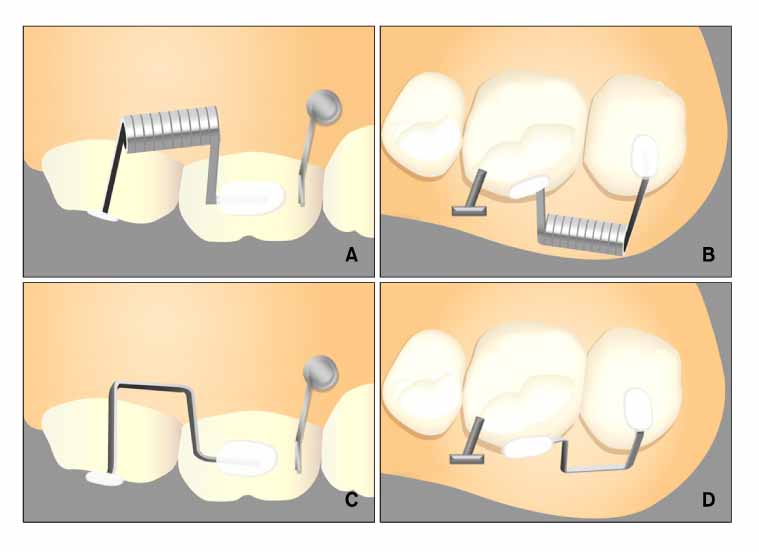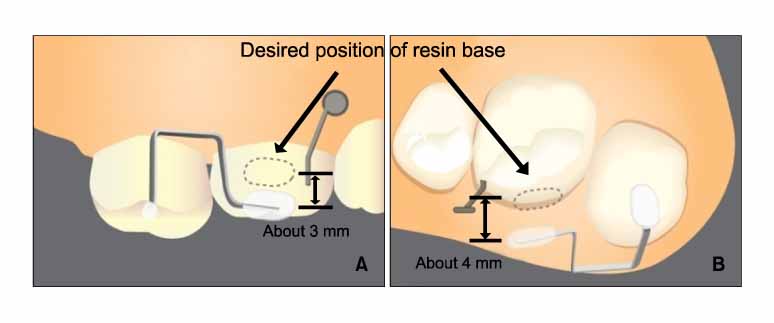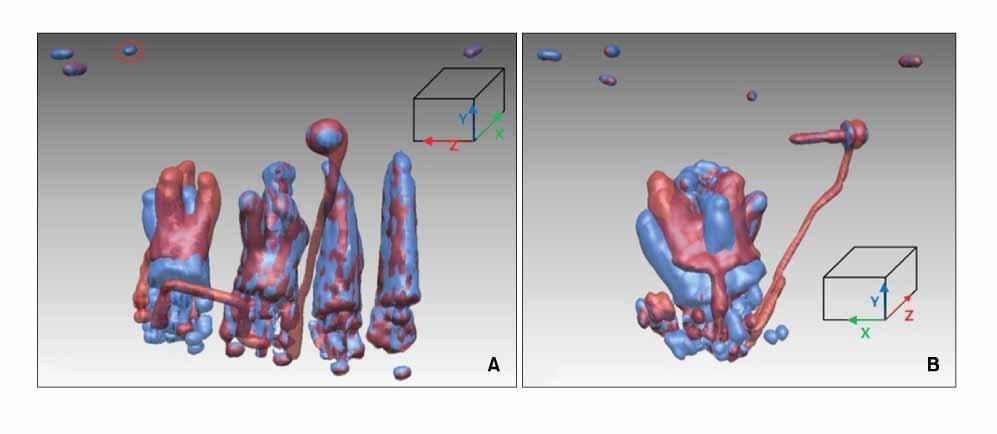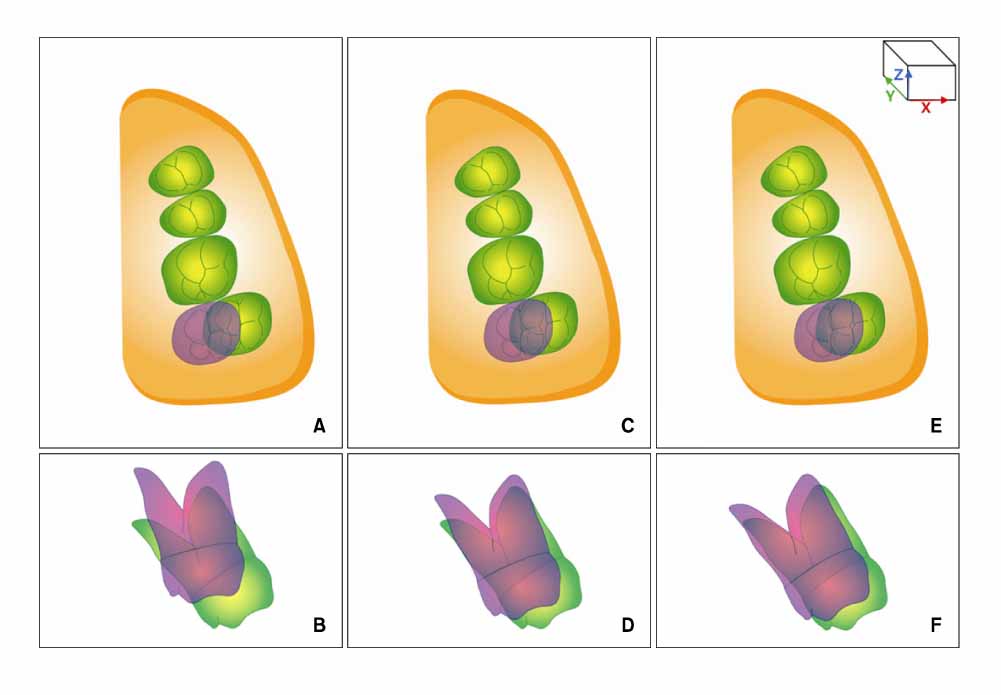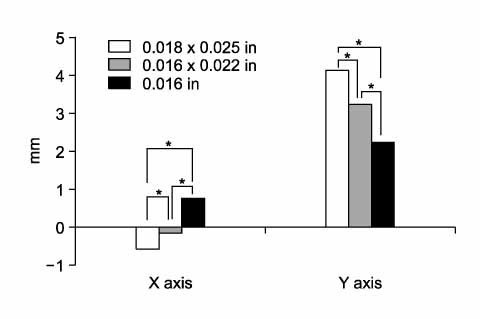Korean J Orthod.
2009 Feb;39(1):43-53. 10.4041/kjod.2009.39.1.43.
Three dimensional analysis of tooth movement using different sizes of NiTi wire on NiTi scissors-bite corrector
- Affiliations
-
- 1Division of Orthodontics, Department of Dentistry, Ewha Womans University Mokdong Hospital, Korea.
- 2Division of Orthodontics, Department of Dentistry, School of Medicine, Ewha Womans University, Korea. drpark@ewha.ac.kr
- 3Department of Preventive Medicine, School of Medicine, Ewha Womans University, Korea.
- 4Division of Orthodontics, Department of Dentistry, School of Medicine, Ewha Womans University, Korea.
- KMID: 1469138
- DOI: http://doi.org/10.4041/kjod.2009.39.1.43
Abstract
OBJECTIVE
The purpose of this study was to compare the difference in three dimensional tooth movement using three different wire sizes (0.018 x 0.025-in, 0.016 x 0.022-in, 0.016-in) on a NiTi scissors-bite corrector.
METHODS
Computed tomography (CT) images of the experimental model before and after tooth movement were taken and reconstructed into three dimensional models for superimposition. The direction and the amount of tooth movement were measured and analyzed statistically.
RESULTS
The lingual and intrusive movements of the crown of the maxillary second molar were increased as the size of the NiTi wire increased. The roots of the maxillary second molars moved buccally except for the 0.016-in group. The intrusive movement of the roots of the maxillary second molars was increased as the size of the NiTi wire increased. Due to the use of orthodontic mini-implants, anchorage loss was under 0.2 mm on average.
CONCLUSIONS
The 0.018 x 0.025-in NiTi wire was most effective in lingual and intrusive movement of the maxillary second molar which was in scissors-bite position. Indirect skeletal anchorage with a single orthodontic mini-implant was rigid enough to prevent anchorage loss.
Figure
Cited by 2 articles
-
Pharyngeal airway analysis of different craniofacial morphology using cone-beam computed tomography (CBCT)
Yong-Il Kim, Seong-Sik Kim, Woo-Sung Son, Soo-Byung Park
Korean J Orthod. 2009;39(3):136-145. doi: 10.4041/kjod.2009.39.3.136.Effects of bracket slot size during
en-masse retraction of the six maxillary anterior teeth using an induction-heating typodont simulation system
Ji-Yong Kim, Won-Jae Yu, Prasad N. K. Koteswaracc, Hee-Moon Kyung
Korean J Orthod. 2017;47(3):158-166. doi: 10.4041/kjod.2017.47.3.158.
Reference
-
1. Ogihara K, Nakahara R, Koyanagi S, Suda M. Treatment of a Brodie bite by lower lateral expansion: a case report and fourth year follow-up. J Clin Pediatr Dent. 1998. 23:17–21.2. Heikinheimo K, Salmi K, Myllärniemi S. Identification of cases requiring orthodontic treatment. A longitudinal study. Swed Dent J Suppl. 1982. 15:71–77.3. Thilander B, Wahlund S, Lennartsson B. The effect of early interceptive treatment in children with posterior cross-bite. Eur J Orthod. 1984. 6:25–34.
Article4. Pirttiniemi P, Kantomaa T. Relation of glenoid fossa morphology to mandibulofacial asymmetry, studied in dry human Lapp skulls. Acta Odontol Scand. 1992. 50:235–243.
Article5. Kucher G, Weiland FJ. Goal-oriented positioning of upper second molars using the palatal intrusion technique. Am J Orthod Dentofacial Orthop. 1996. 110:466–468.
Article6. Enacar A, Pehlivanoglu M, Akcan CA. Molar intrusion with a palatal arch. J Clin Orthod. 2003. 37:557–559.7. Nakamura Y, Murata K, Ogino T, Sekiya T, Hirashita A. Intrusion of overerupted upper second molars with a modified lingual arch. J Clin Orthod. 2004. 38:622–626.8. Legan HL. Orthodontic planning and biomechanics for transverse distraction ostegenesis. Semin Orthod. 2001. 7:160–168.
Article9. Baeten LR. Canine retraction: a photoelastic study. Am J Orthod. 1975. 67:11–23.
Article10. Burstone CJ, Pryputniewicz RJ. Holographic determination of centers of rotation produced by orthodontic forces. Am J Orthod. 1980. 77:396–409.
Article11. Caputo AA, Chaconas SJ, Hayashi RK. Photoelastic visualization of orthodontic forces during canine retraction. Am J Orthod. 1974. 65:250–259.
Article12. Moss ML, Skalak R, Patel H, Sen K, Moss-Salentijn L, Shinozuka M, et al. Finite element method modeling of craniofacial growth. Am J Orthod. 1985. 87:453–472.
Article13. Weijs WA, de Jongh HJ. Strain in mandibular alveolar bone during mastication in the rabbit. Arch Oral Biol. 1977. 22:667–675.
Article14. Ogura M, Yamagata K, Kubota S, Kim JH, Kuroe K, Ito G. Comparison of tooth movements using Friction-Free and preadjusted edgewise bracket systems. J Clin Orthod. 1996. 30:325–330.15. Drescher D, Bourauel C, Thier M. Application of the orthodontic measurement and simulation system (OMSS) in orthodontics. Eur J Orthod. 1991. 13:169–178.
Article16. Rhee JN, Chun YS, Row J. A comparison between friction and frictionless mechanics with a new typodont simulation system. Am J Orthod Dentofacial Orthop. 2001. 119:292–299.
Article17. Cha BK, Lee JY, Bae SH, Park DI. Preliminary study of future orthodontic model analysis: the orthodontic application of 3-dimensional reverse engineering technologies. J Korean Dent Assoc. 2002. 40:107–107.18. Yun SW, Lim WH, Chong DR, Chun YS. Scissors-bite correction on second molar with a dragon helix appliance. Am J Orthod Dentofacial Orthop. 2007. 132:842–847.
Article19. Chun YS, Row J, Suh MS, Park IK. An experimental study on the dynamic tooth moving effects of two precision lingual archs(Pla) for correction of posterior scissor bite by the calorific machine. Korean J Orthod. 1998. 28:29–41.20. Proffit WR, Fields HW, Sarver DM. Contemporary orthodontics:. 2007. St.Louis: Mosby;340.21. Melsen B, Agerbaek N, Eriksen J, Terp S. New attachment through periodontal treatment and orthodontic intrusion. Am J Orthod Dentofacial Orthop. 1988. 94:104–116.
Article
- Full Text Links
- Actions
-
Cited
- CITED
-
- Close
- Share
- Similar articles
-
- The moment generated by the torque of the orthodontic rectangular wire : Three-dimensional finite element analysis
- Comparison of the frictional resistance between orthodontic bracket & archwire
- Minor Orthodontic Treatment Using NiTi Wire Exerting Light Force: Case Reports
- Effect of friction from differing vertical bracket placement on the force and moment of NiTi wires
- Regional load deflection rate of multiloop edgewise archwire


